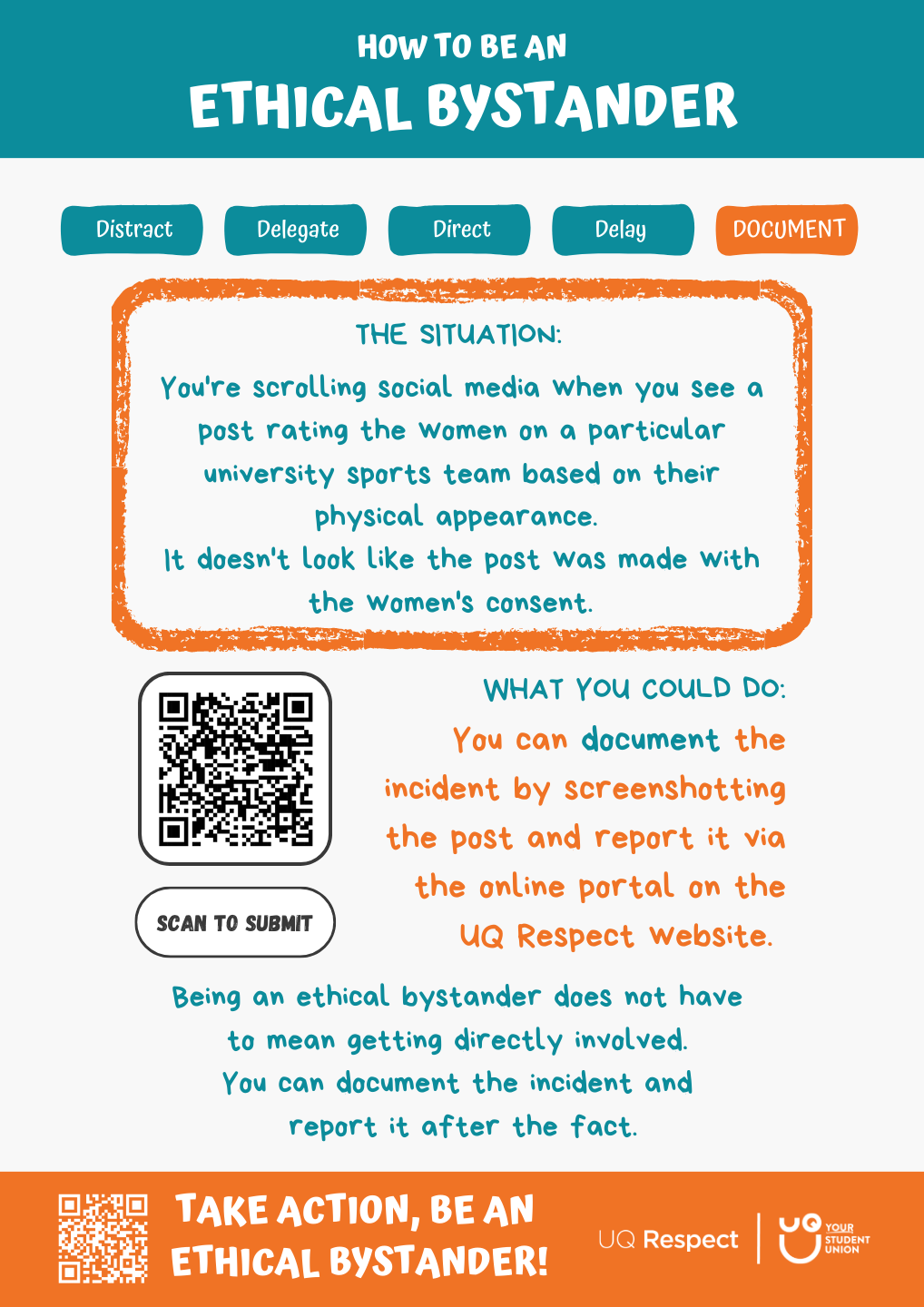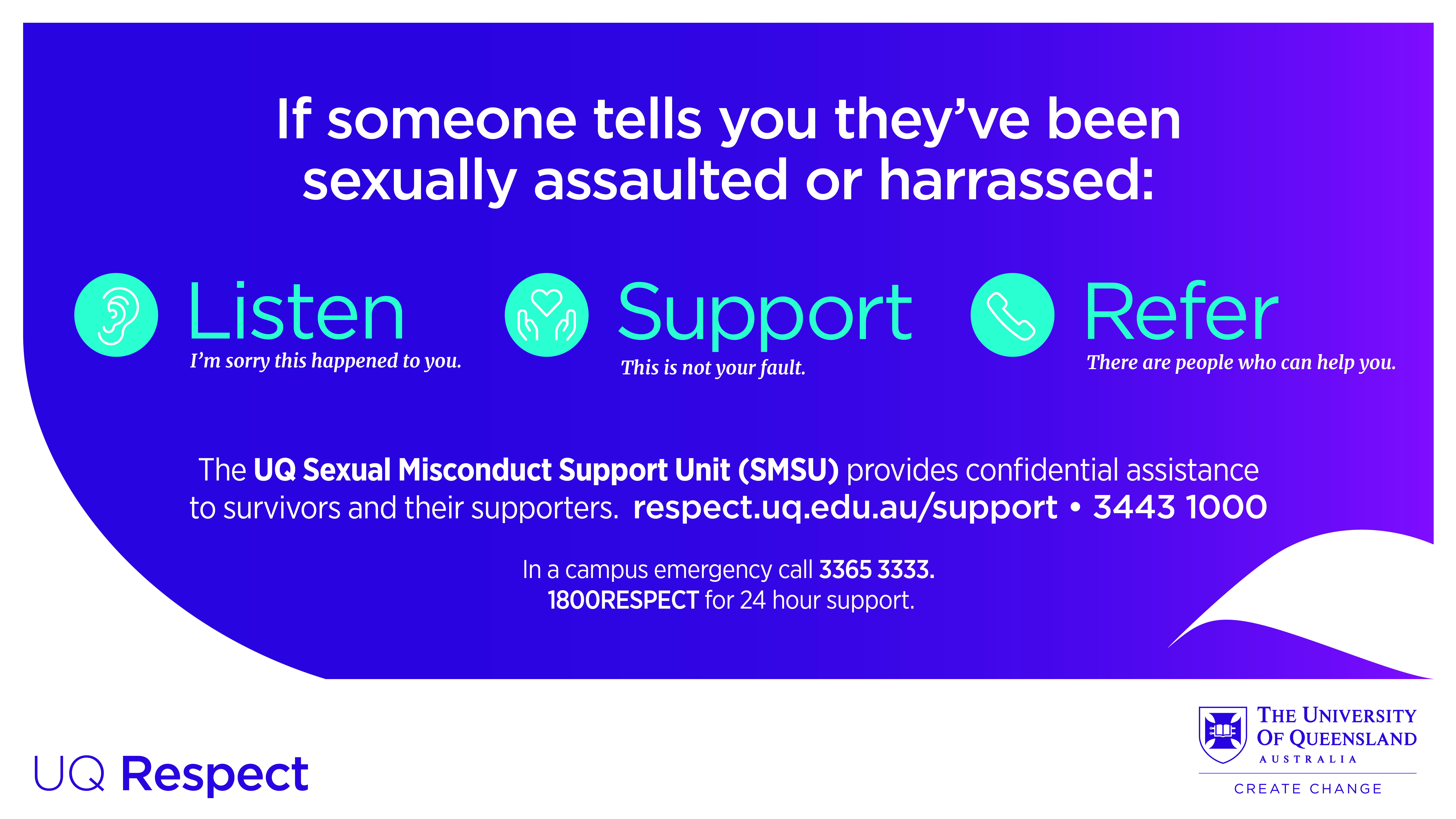- Who is an ethical bystander?
- How to be an ethical bystander?
- When to be an ethical bystander?
- Some useful links
A bystander is someone who witnesses an event. An ethical bystander is someone who witnesses an event that is disrespectful or harmful, chooses to do something, and considers the safest way to intervene. Ethical bystanders play an essential role in building a culture of respect and making UQ, and the broader community, a safer space.
In 2016, 25% of students at universities across Australia witnessed another student being sexually harassed. Almost a quarter of those students took action in response. The most common response was talking to the survivor (person who experienced the harassment), followed by talking to the perpetrator (person who did the harassment).1 Small actions can make a big difference!
Knowing how to intervene when you witness a harmful or disrespectful behaviour can be challenging. The 2021 National Student Safety Survey results found that the most common reason students did not take action when they witnessed sexual harassment was that they did not know how to take action.
We launched the Ethical Bystander Campaign to change this, and provide members of the UQ community with a set of tools they can use if they witness a disrespectful or harmful situation. Here at UQ, we use the 5 Ds of Bystander Intervention — a set of 5 different strategies you can use when taking action as an ethical bystander.
The most important thing to consider as an ethical bystander is safety for yourself and others involved. There are lots of ways to be an ethical bystander that do not necessarily mean getting directly involved. There is no 'right' way to be an ethical bystander — depending on the situation, you may feel more comfortable using one of the 5 Ds over another.
Distract
Distraction aims to interrupt an incident involving disrespectful behaviour and de-escalate or change the trajectory of the situation. Distraction can also provide the person experiencing the disrespectful behaviour with a way out of the situation.
For example, if you witness a friend looking uncomfortable in an interaction with another person at a bar, you could ask them if they want to come to the bathroom or get some water with you.
If you witness an incident of harassment or disrespectful behaviour on campus, you might approach the person being harassed and ask them for directions to a certain place.
Delegate
Sometimes the best way to intervene is to get someone else involved. You may be able enlist other people present to help, such as the person’s friends, bar staff, door staff or a university staff member depending on where you are. Enlisting someone else to stay present or Distract from the situation may be useful while you find someone to delegate to. Remember to download the UQ SafeZone App to give you direct access to on campus security.
In an emergency, call (07) 3365 333 (on-campus) or 000 (off-campus).
Direct
If you are going to directly intervene in a situation, always remember to assess your safety first. If you feel comfortable and safe to do so, consider directly telling someone their behaviour is not appropriate. You may also be able to reassure the person experiencing the harassment and help them move away from the situation.
If one of your peers is making disrespectful comments, you can use subtle approaches to show you don’t agree. You could simply roll your eyes, leave the conversation or say “Hey, that’s not ok”. If someone makes a disrespectful joke, telling them "I don't get it" or asking them to explain the joke can be a good way to get them to reflect on their words.
The Line has some great tips for how to address gender inequality and misogyny with your mates.
Delay
Bystanders can play an important role even after an incident has occurred. Consider checking in with the person who was subjected to the disrespectful or harmful behaviour and offer them support. More information on how to support someone who has experienced a sexual assault is available here.
You can also take action after the incident has occurred by speaking with the person who said or did something disrespectful, to encourage them to reflect on their behaviour. For example, if someone made a disrespectful comment or joke, you might ask them "What was your intention when you said that?".
Please note: If you witness an incident that is harmful or poses a risk to someone's safety, it is important to take immediate action instead of delaying. Consider using the Delegate, Distract or Direct strategies.
We have launched the student-focused Listen, Support, Refer campaign, which aims to promote sensitive and trauma-informed responses to disclosures made by your peers.
Document
Documenting an incident can look like recording a disrespectful or harmful incident by taking a recording or notes about the situation. It can be helpful for the person who experienced the disrespectful behaviour to have evidence of the incident, in case they decide to make a report.
Before you document a situation, ask yourself "Is anyone helping the person experiencing the disrespectful behaviour?". If the answer is no, consider using another of the 5 Ds to assist them first.
If you are documenting an incident on your phone, it is a good idea to try to capture street signs or landmarks to document the location of an incident. Always remember to consider the privacy of the victim/survivor. Never post photos or footage of an incident online, or use it, without the permission of the survivor.
If you witness an incident involving sexual misconduct on campus, you can make a disclosure to the Sexual Misconduct Support Unit (SMSU) here and can choose to remain anonymous if you wish. More information about reporting incidents of sexual assault or harassment is available here.
Anytime you witness something that concerns you, you have the opportunity to be an ethical bystander. Being an ethical bystander is not about being a hero. Ethical bystanders notice something they think is dangerous, inappropriate or unjust, and decide they can do something about it.
Remember that sexual misconduct can look different in different situations and can include behaviours such as unwanted physical touching, 'jokes' of a sexual nature, whistling and catcalling, or comments about someone's appearance. To learn more about sexual misconduct, click here.
We know that behaviours, words and actions that normalise, minimise or condone violence are often at the root of bigger issues such as sexual violence. Sexist jokes, comments about a person’s appearance, whistling and catcalling, and derogatory comments about someone’s ability based on gender or racial slurs, all need to be challenged in order for us to promote safety and respect.
Prevention requires all of us to challenge sexist, racist, homophobic, xenophobic and transphobic comments! A simple "That's not cool" in response to a sexist 'joke' can make a big impact.
Follow your instincts, if something does not feel right, and if it is safe to do so, then take action.
Websites
![]() Check out some real life scenario’s by the No More Campaign for more ideas about when and how to intervene.
Check out some real life scenario’s by the No More Campaign for more ideas about when and how to intervene.
Videos
References
1. Australian Human Rights Commission. Change the course: national report on sexual assault and sexual harassment at Australian Universities. Sydney: Australian Human Rights Commission; 2017.
2. Public Access Direct. Show Up: your guide to bystander intervention. New York, NY: Centre for Urban Pedagogy; 2017.
How to be an Ethical Bystander – The Five 'D's
The Five 'D's
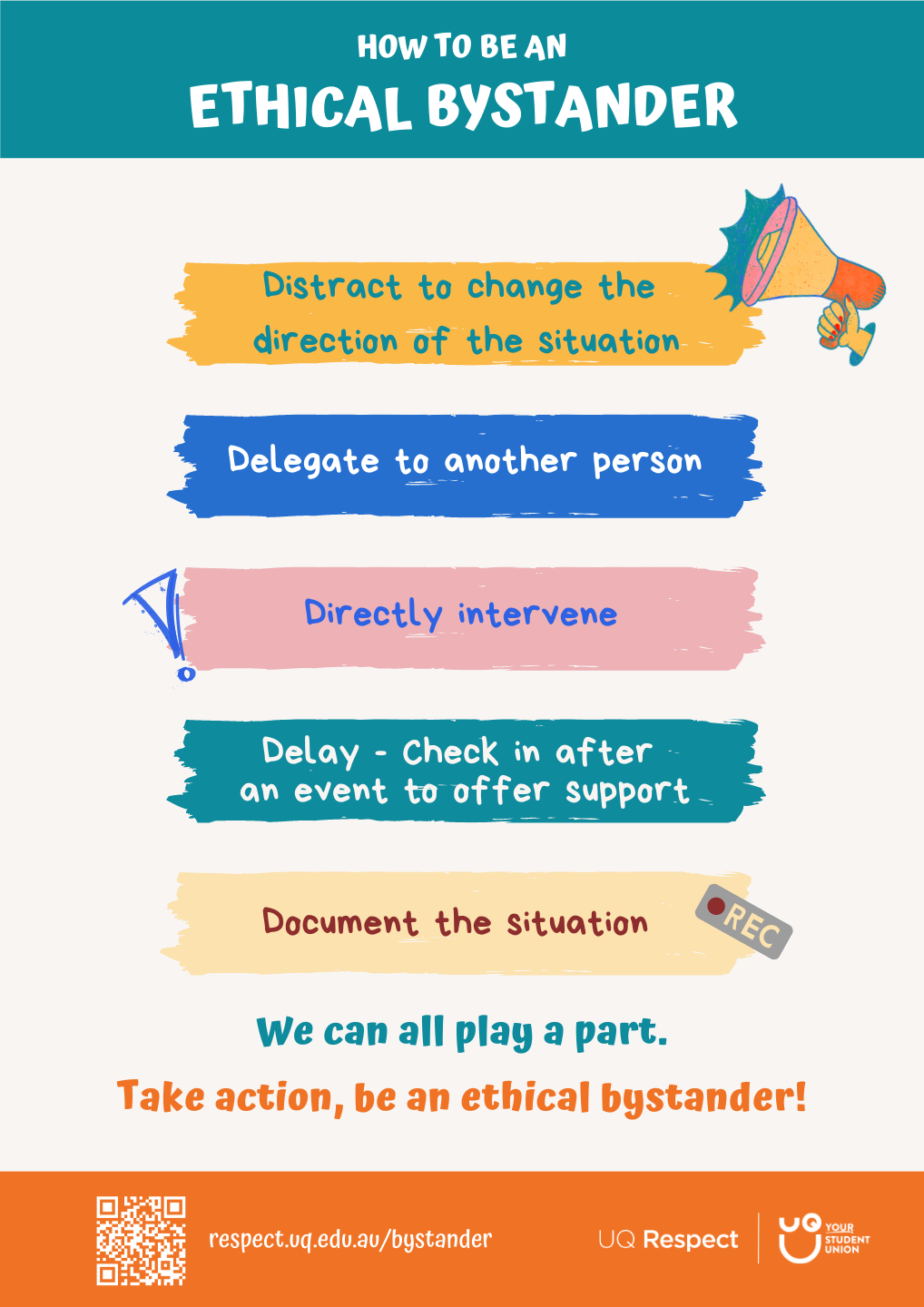
Distract – Scenario 1
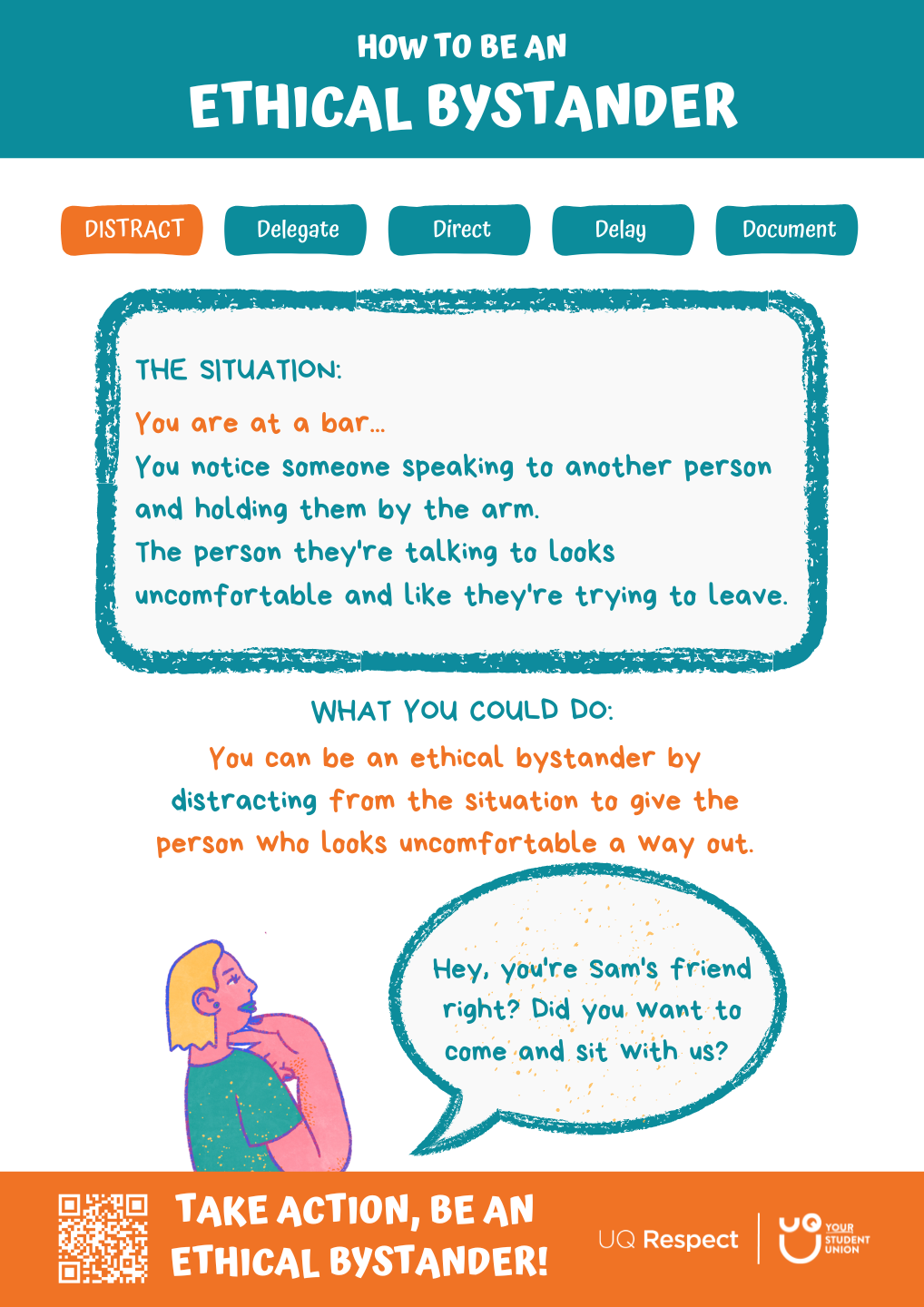
Distract – Scenario 2
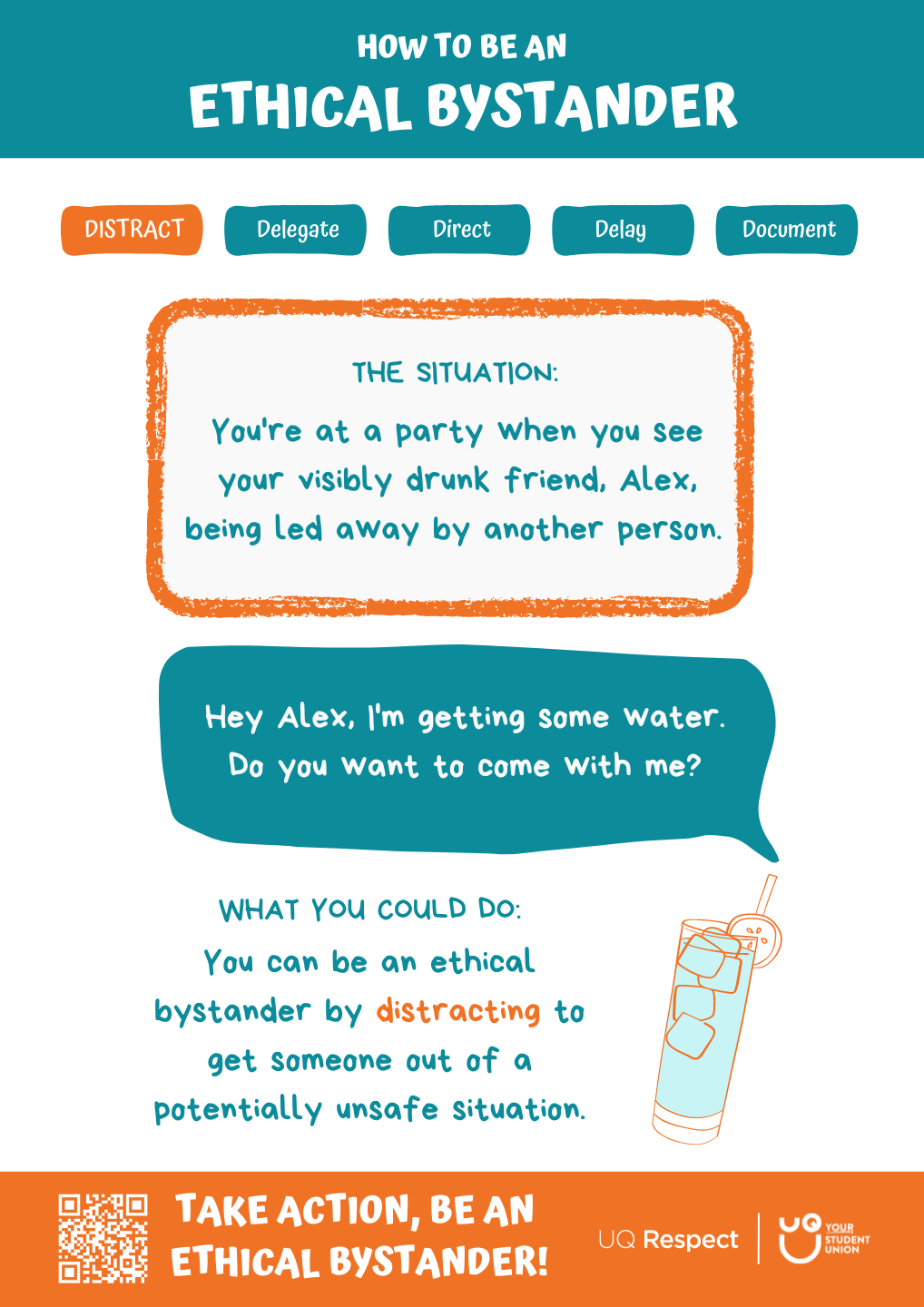
Delegate – Scenario 1
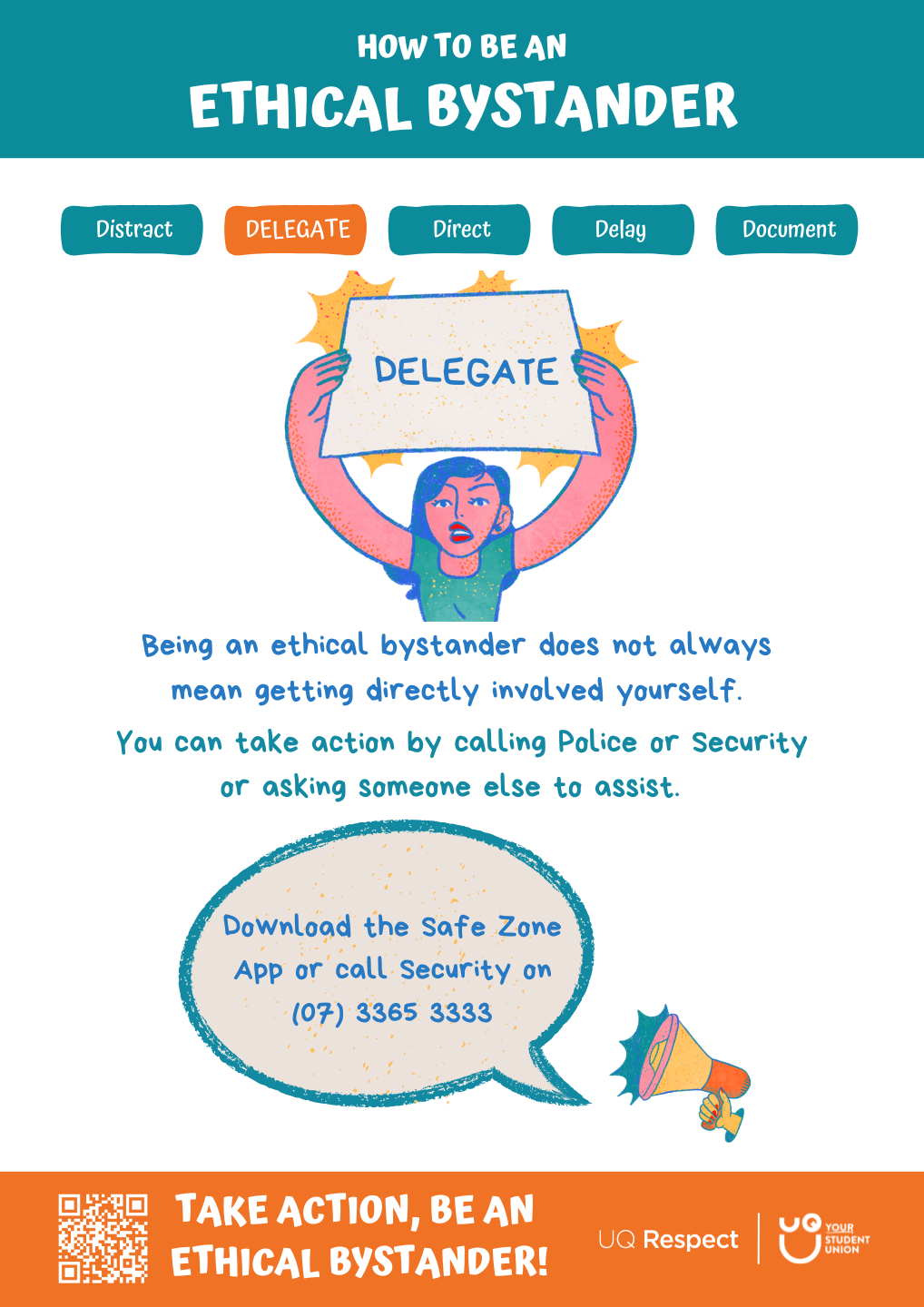
Delegate – Scenario 2
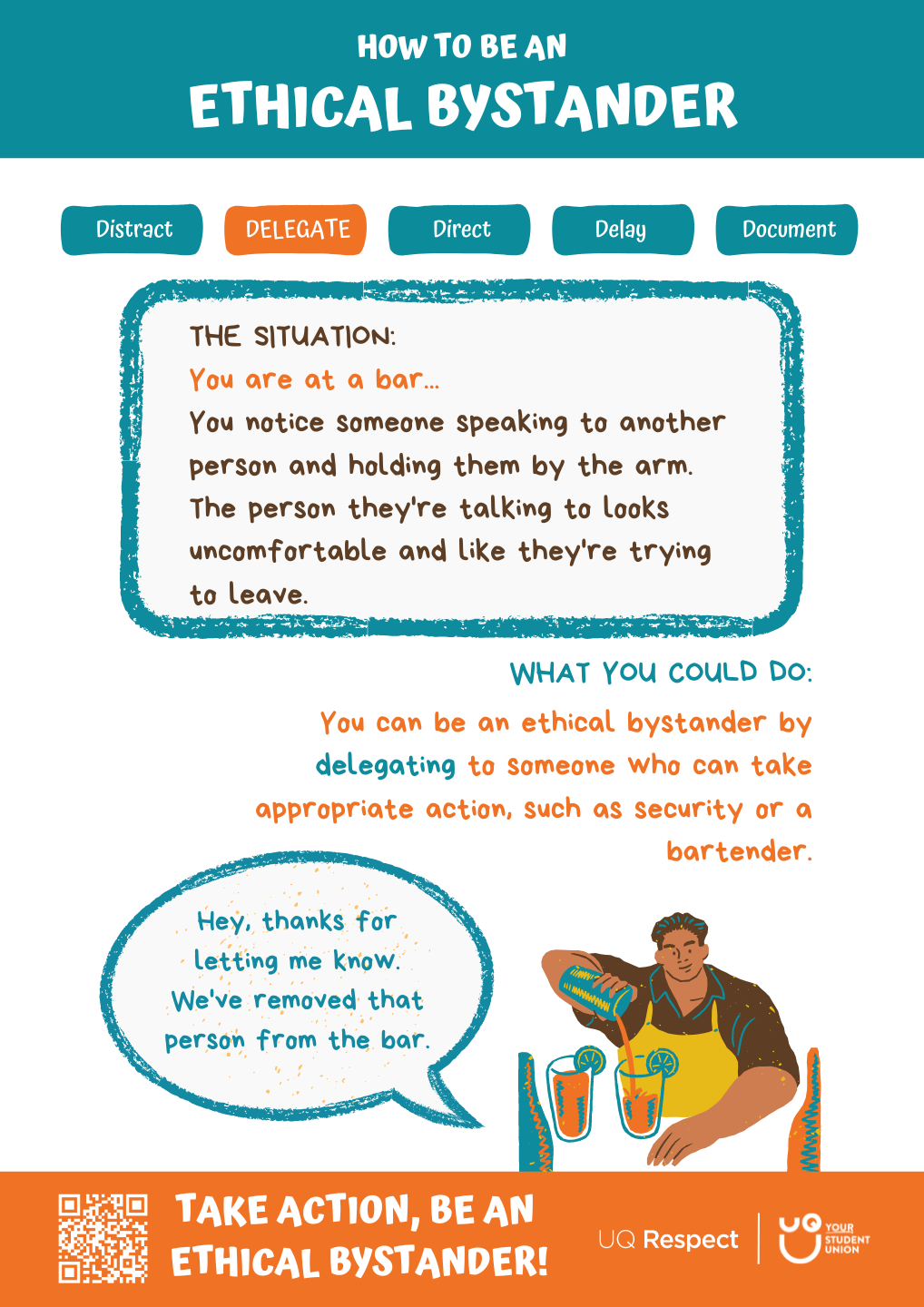
Direct – Scenario 1
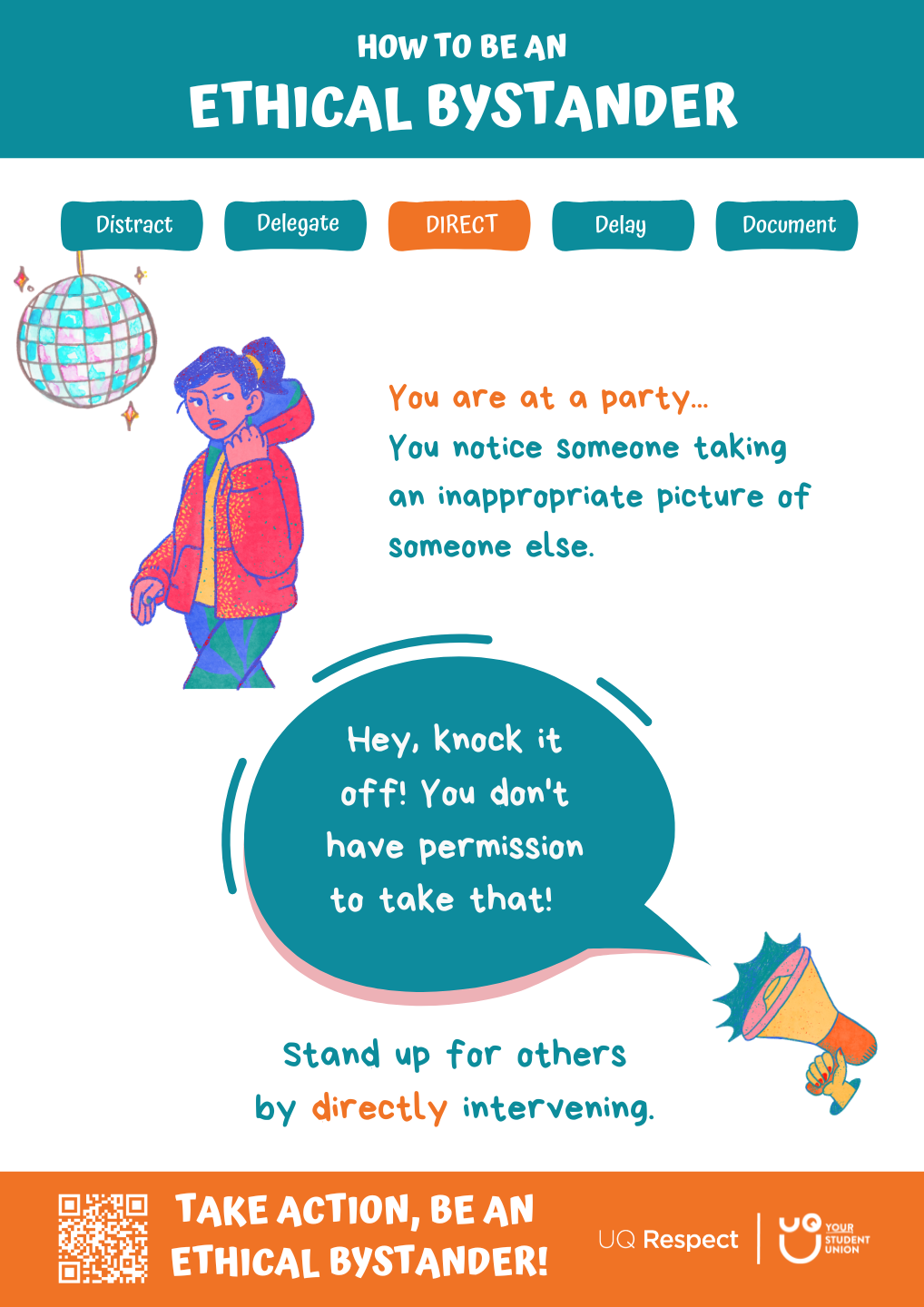
Direct – Scenario 2
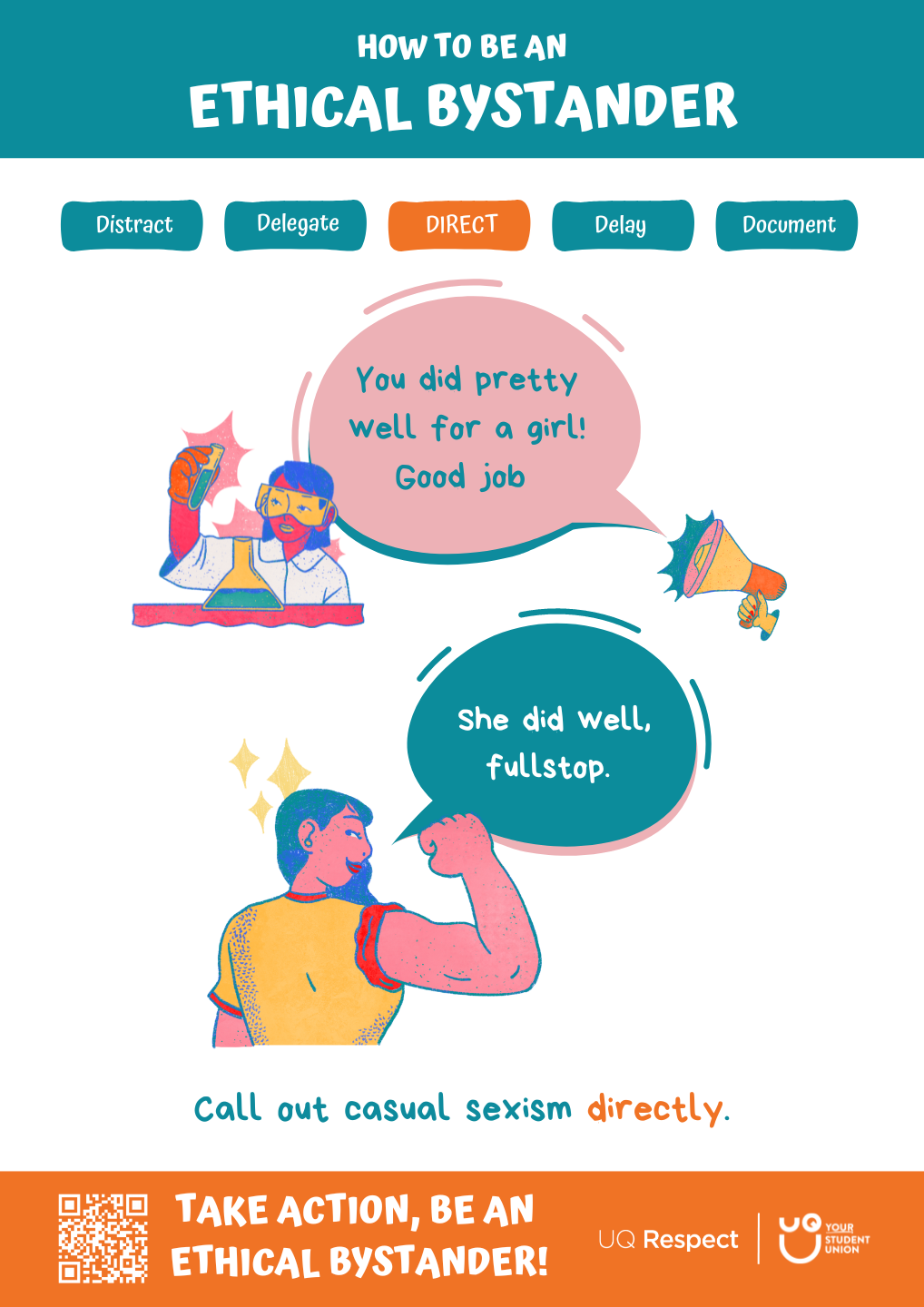
Delay – Scenario 1
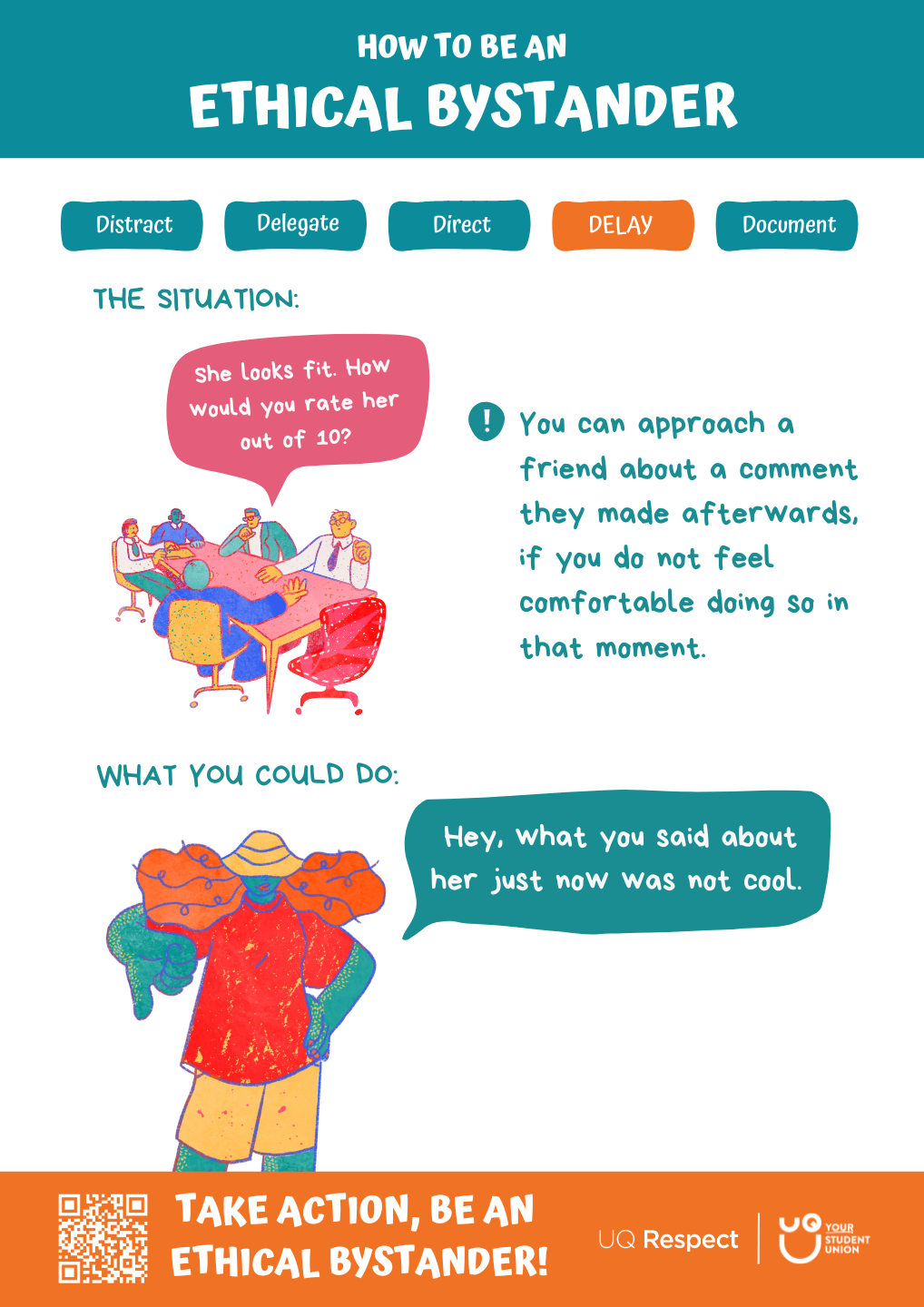
Delay – Scenario 2
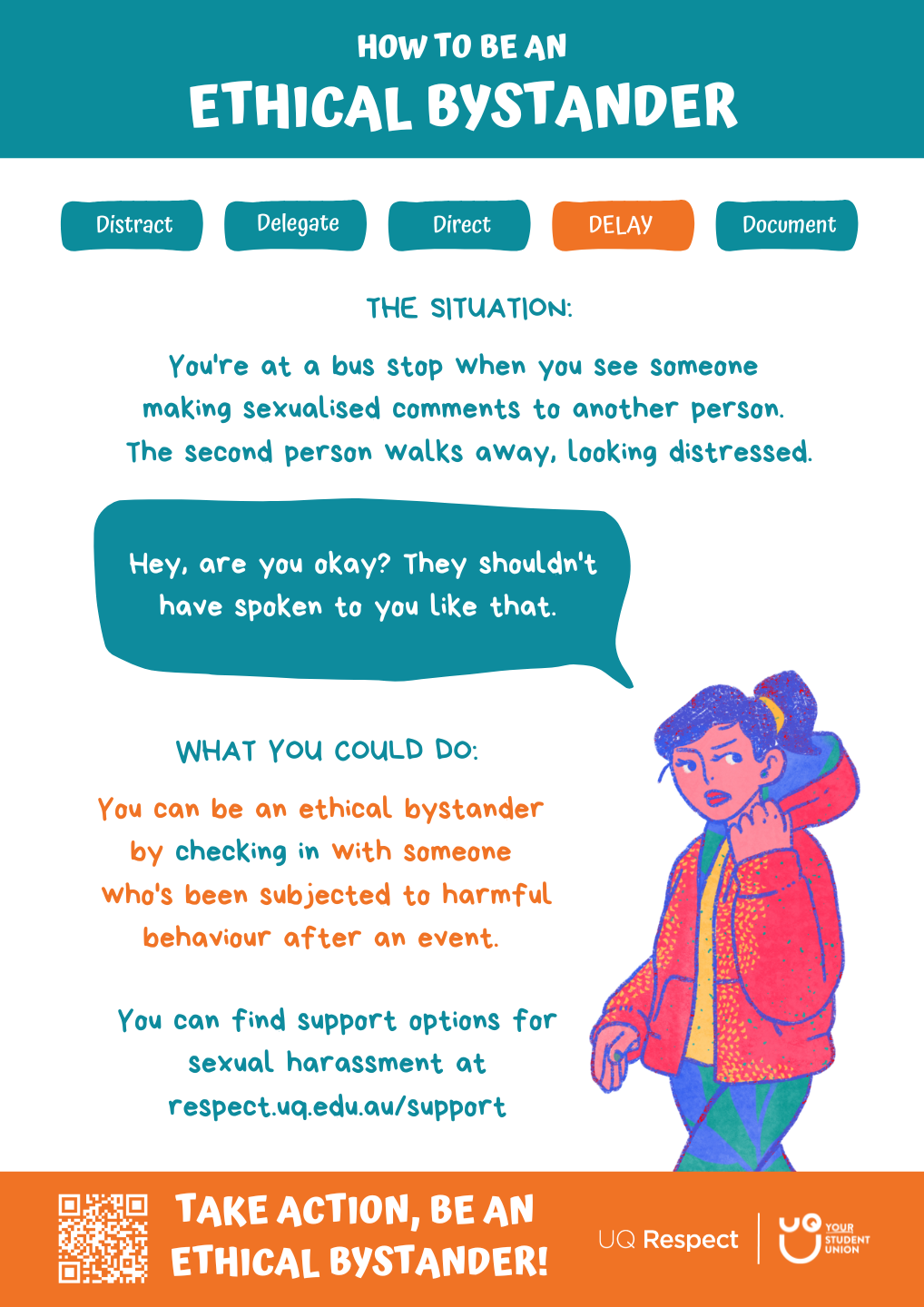
Document – Scenario 1
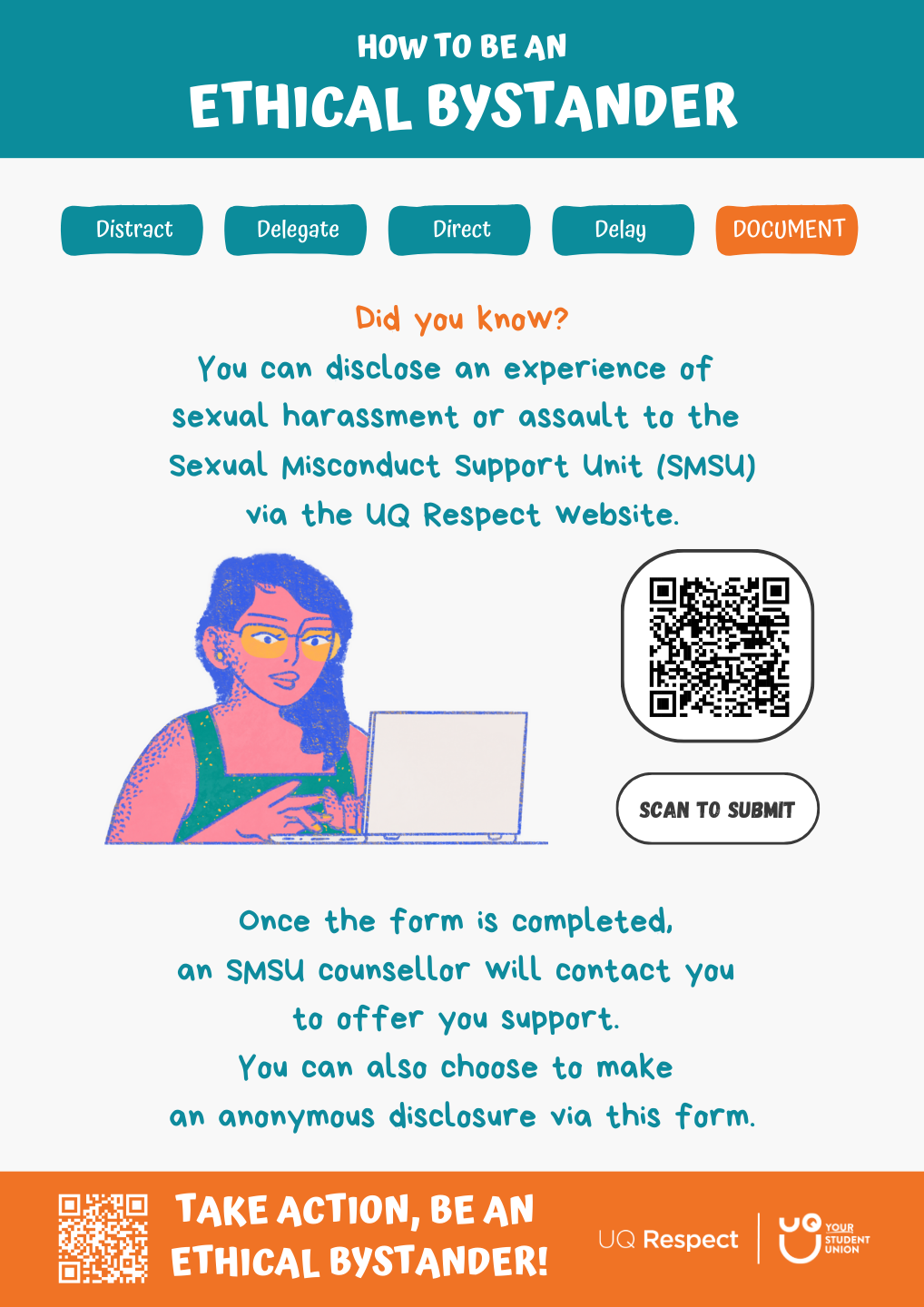
Document – Scenario 2
